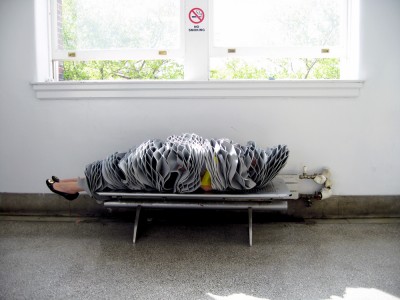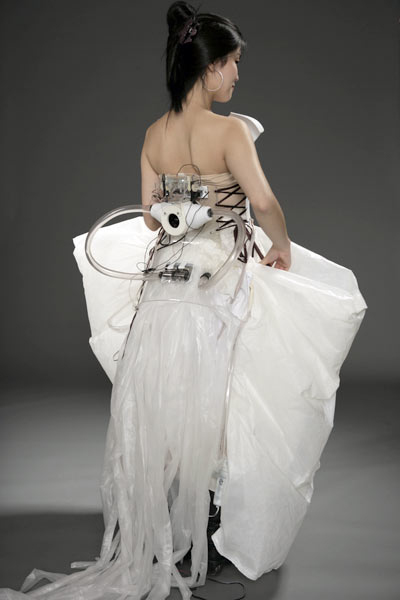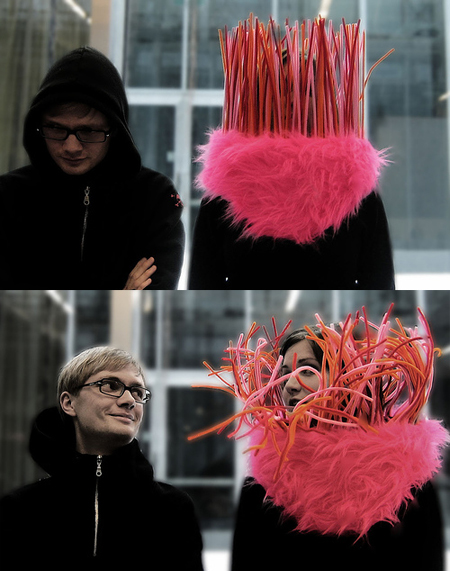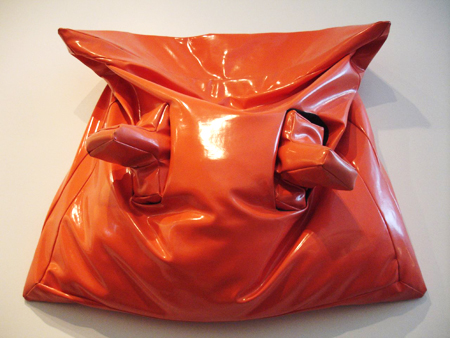Fashion designer Catherine Chow has been inspiring the fashion and art community for years with her avant-garde approach to her garments and her longing to push the boundaries of everyday materials. So, I wanted to resurrect one of her projects that she did a few years ago that fast-tracked her to fame and that is still so beautifully inspiring...her zipper dress. The dress, a wedding gown, consists of a single zipper that requires it to be unfurled and unzipped to remove. I love the simple (and analog) interaction of this garment and the story that the interaction tells. Since the garment is a wedding dress, it comes with all of the connotations, history and cultural context of wedding traditions. In this case, the brilliantly simple interaction whimsically enhances the tradition of "the wedding night" by providing an evocative experience of carefully unfurling it for the "big reveal" that becomes a form of seduction and foreplay on this important night. It's a great example of striking the right balance among the context of the garment and its cultural traditions, the implied interaction, and the narrative the experience reveals...er... tells. Image from metropolismag.com An interesting interview at fashionprojects.org More on Catherine Chow
Architecting a sleeping suit
 Architect Forrest Jessee is dabbling in architecture structures applied to garments in this gorgeous and cocoon-like functional pattern. "Inspired by Buckminster Fuller’s practice of Dymaxion Sleeping, which involves four segments of half-hour naps every six hours, Jessee redefined the sleeping ritual while challenging the roles of private and public space by designing the portable Sleep Suit. Structural pleats made of EVA foam which absorbs shock in sports equipment is used to “dress” or contain the body much like a sleeping bag. By testing and recording sleeping positions, areas of comfort and discomfort are identified, and thus determined the thickness of the foam where the support is needed. I can’t help but be reminded of the napping challenges endured by taking on the benches, crates, floors and chairs during my architecture school days." (source)
Architect Forrest Jessee is dabbling in architecture structures applied to garments in this gorgeous and cocoon-like functional pattern. "Inspired by Buckminster Fuller’s practice of Dymaxion Sleeping, which involves four segments of half-hour naps every six hours, Jessee redefined the sleeping ritual while challenging the roles of private and public space by designing the portable Sleep Suit. Structural pleats made of EVA foam which absorbs shock in sports equipment is used to “dress” or contain the body much like a sleeping bag. By testing and recording sleeping positions, areas of comfort and discomfort are identified, and thus determined the thickness of the foam where the support is needed. I can’t help but be reminded of the napping challenges endured by taking on the benches, crates, floors and chairs during my architecture school days." (source)
View all the photos and read more about this project on Pleat Farm.
Diana Eng's inflatable dress
 This is an older project, but still worth a reminder. Diana Eng, in collaboration with Emily Albinski, created this gorgeous dress way back in 2003, which ended up making its way on the cover of ID Magazine. The designers used this project to explore how they could use electronics to change the shape and color of a gown. The dress inflates to allow you to change it's shape. Pump up the back or the sides to change its silhouette.
This is an older project, but still worth a reminder. Diana Eng, in collaboration with Emily Albinski, created this gorgeous dress way back in 2003, which ended up making its way on the cover of ID Magazine. The designers used this project to explore how they could use electronics to change the shape and color of a gown. The dress inflates to allow you to change it's shape. Pump up the back or the sides to change its silhouette.
The designers made no attempt to hide the electronics, rather, they exposed the spaghetti-ball of wires and components as the main aesthetic. This was a pretty outrageous design at the time. Since then, inflatable and shape-shifting garments have been a topic of exploration from designers such as Hussein Chalayan, Extra-Soft (XS) labs, Ying Gao, and Teresa Almeida.
Exploring the effects of personal volume
 Designers Einar, Castillñano and Anette Andersen, call their collective the Spatials. They collaborated on a project that explores private and personal spaces and how they are affected by our surroundings and emotions. In this exploration, the collar of the garment reacts to various sensor inputs that control the strings via air pumps. The response either hides or reveals the wearer while the strings consume more or less of the space surrounding her.
Designers Einar, Castillñano and Anette Andersen, call their collective the Spatials. They collaborated on a project that explores private and personal spaces and how they are affected by our surroundings and emotions. In this exploration, the collar of the garment reacts to various sensor inputs that control the strings via air pumps. The response either hides or reveals the wearer while the strings consume more or less of the space surrounding her.
A similar project is Teresa Almeida's Space Dress, which provides personal space in public places that I wrote about last month. Check out the posting here.
View more on the project on Andersen's blog.
Soft switch sculptures
 Artist and sculptor Claes Oldenburg is probably best known for his public art installations that play with very large scale objects. Another theme in his work is the idea of "soft" that he applies in unexpected ways to everyday, ubiquitous objects. With this piece, Oldenburg takes ordinary light switches and applies an unexpected material that makes it feel soft and squishy. This particular piece makes me think of all the soft-switch explorations coming out of the DIY culture, where designers and tinkerers are investigating new ways to turn ordinary switches and sensors into soft and flexible mechanisms.
Artist and sculptor Claes Oldenburg is probably best known for his public art installations that play with very large scale objects. Another theme in his work is the idea of "soft" that he applies in unexpected ways to everyday, ubiquitous objects. With this piece, Oldenburg takes ordinary light switches and applies an unexpected material that makes it feel soft and squishy. This particular piece makes me think of all the soft-switch explorations coming out of the DIY culture, where designers and tinkerers are investigating new ways to turn ordinary switches and sensors into soft and flexible mechanisms.
Sleeping jacket
 Matthew Gale designed a jacket that functions as a sleeping aid for when you're on public transit, called Excubo. He came up with the concept after learning that people sleep on public transportation when their bodies are held in a rigid state rather than loose and bouncing around.
Matthew Gale designed a jacket that functions as a sleeping aid for when you're on public transit, called Excubo. He came up with the concept after learning that people sleep on public transportation when their bodies are held in a rigid state rather than loose and bouncing around.
Couple this idea with Timothy Dubitsky's Hood.e that integrates headphones into the hood and you can drown out the ambient noise that comes with public transportation by lulling yourself to sleep with your music. All of this, of course, would be discretely integrated into the garment so it becomes your second skin while helping you catch your Z's.